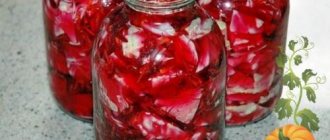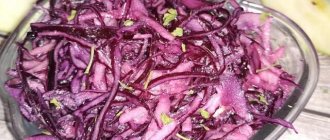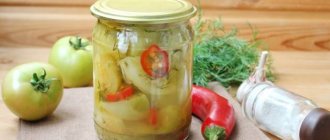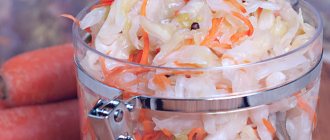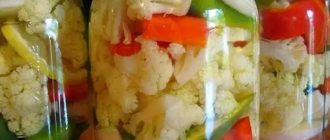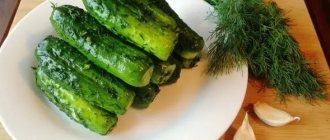Salted cabbage is the most common winter preparation among the population. The product is healthy, tasty and easy to prepare. There are a lot of recipes. Therefore, everyone will definitely find the ideal option for themselves on how to properly salt cabbage in jars for the whole family for the winter. The main thing is to just rely on the taste preferences of your household and learn a few simple rules regarding pickling.
Little tricks are the key to successful salting
Every year, with the arrival of autumn, the question of how to salt crispy cabbage for the winter becomes relevant. There cannot be a definite answer to this question, since the ripening process is quite delicate and even a seemingly insignificant factor can have a detrimental effect on the preservation and souring of cabbage. So, when deciding to prepare sauerkraut for the winter, you need to consider the following important points:
Variety selection
Only mid-early and late varieties of cabbage are suitable for pickling. Such heads of cabbage are always dense, juicy, large, and contain a large amount of sugar, which is actively involved in the fermentation process. This cabbage can be stored fresh for a long time under certain temperature conditions. The shelf life of some varieties is 6 and sometimes 8 months. Sourdough further extends the storage period: properly prepared sauerkraut can be stored until the next season.
Among all the variety, cabbage varieties such as “Slava”, “Valentina”, “Podarok” and some others are recognized as the best for pickling and long-term winter storage.
When choosing cabbage for pickling, you need to pay attention to the external characteristics of the heads: when squeezed, a fresh, mature vegetable should spring slightly. The weight of the head of cabbage should be at least 3 kg, and on its surface there should be as few green and damaged leaves as possible. They are unsuitable for fermentation and, in fact, will be production waste. Vegetables with cracks, signs of spoilage or rotting are not suitable for sourdough.
Important cooking rules
In order for salted cabbage to be tasty and crispy, you must not only use a proven recipe, but also follow certain cooking rules:
- It is recommended to ferment cabbage in a glass, plastic or enamel container. Having chosen an enameled container, you need to carefully inspect it for internal chips and scratches. Containers with internal damage are not suitable for fermenting cabbage. The best option for sourdough may be an oak barrel, but it is not always possible to find one. Iron or aluminum containers cannot be used for fermentation. Contact of an acidic vegetable with metal will change the taste of the product.
- During the cooking process, you must use only clean tools and utensils. For some, this rule may seem banal, but often it is the presence of “foreign” bacteria that leads to cabbage being fermented incorrectly and its taste as a result becoming indecent. You can achieve purity of preparation using saline (1 tablespoon of salt per 1 liter of boiling water) or alcohol solution. The cook should treat the cutting board, knife, and fermentation container with a disinfectant.
- Iodized salt is not suitable for making pickled snacks or any other winter preparations. For these purposes, it is better to use ordinary rock salt. You can add a preservative to the cabbage to taste, but to make it crispy, it is recommended to add 1 tbsp. l. salt per 1 kg of finished product.
- You need to cut the cabbage into approximately equal slices, 0.5-0.6 mm wide. Smaller cuts will destroy many vitamins, and large pieces may not be salted enough or unevenly.
- With the dry fermentation method, the cook must knead the shredded cabbage so that it releases the juice. In this case, it is important not to overdo it, because cabbage that is too soft cannot become crispy when ripened. Thus, experienced housewives recommend applying only a few clicks on the pre-salted vegetable. After this manipulation, you need to compact the product tightly into the container so that the juice completely covers it.
- As a result of fermentation, sauerkraut produces an unpleasant odor, which is caused by carbon dioxide. The resulting gases must be removed from the thickness of the prepared product. To do this, pierce the fermenting vegetables with a knitting needle, skewer or knife that can reach the bottom of the container. It is necessary to remove gases in this way 2-3 times a day. If this is not done, the product will be bitter, unpleasantly smelling, and slimy.
- Cabbage should be fermented at room temperature for 3-4 days. The exact fermentation time depends on the specific conditions, composition of the product, and the taste preferences of the housewife. Once the cabbage has acquired the desired taste, it needs to be “hidden” in a cool place where the fermentation process will stop.
Our ancestors annually prepared sauerkraut in huge volumes. They believed that a product prepared during the waxing moon would definitely turn out tasty and crispy. Also, according to popular belief, the key to success in cooking lies in the good mood of the cook. Perhaps modern housewives who decide to ferment cabbage would also do well to look at the lunar calendar and exchange jokes with their loved ones.
Optimal souring conditions
When the cabbage is moderately fermented, you need to take care of its safety. The optimal condition for storing the finished product is a temperature of -2-+2 0 C. You can “find” such a microclimate in the refrigerator or on the balcony in winter. It is convenient to store sauerkraut in a 3 liter jar. A tightly packed product does not lose juice and does not absorb foreign odors.
The product can only be frozen once.
The best recipes for making crispy sauerkraut
Most often, housewives prepare sauerkraut according to a traditional recipe with carrots, salt and sugar. Cumin, dill seeds or other seasonings can complement the taste of the winter preparation. A snack fermented with beets, apples or fresh lingonberries, cranberries, and rowan berries has a bright color and unusual taste.
A simple crispy snack recipe
For beginner cooks, the best recipe for making sauerkraut may be the classic one. To implement it you will need a main vegetable, carrots, salt and sugar. Carrots contain a lot of natural sugar, which will also promote active fermentation. The bright color of carrots will make the snack look even fresher and more appetizing. It is recommended to add carrots in an amount of 10% by weight of the main vegetable.
If you decide to ferment the product in a 3-liter jar, then you need to calculate for 4 kg of cabbage. This is exactly the amount of shredded vegetable that can fit into the specified volume. Additionally, you need to use 400 g of carrots, 3-4 tbsp. l. salt and 2 tbsp. l. Sahara. It is worth noting that when making sourdough you can do without sugar altogether. In this case, the taste of the snack will be less bright, and the fermentation process itself will take a little longer.
To understand exactly how to pickle cabbage, you can familiarize yourself with the following sequence of work:
- Remove the top green and damaged leaves from the heads of cabbage. Divide the vegetable into 4 parts.
- Finely chop the cabbage. Sprinkle each 1 kg of crushed product with a spoon of salt and knead lightly.
- Peel, wash and grate the carrots. You can chop carrots using a regular grater or a Korean salad grater.
- After preparing the main vegetable, you should thoroughly mix all the ingredients and place them tightly in a 3-liter jar or other container.
- You need to leave some free space in the jar where the juice will accumulate. During the fermentation process, the juice will be actively released, so it is better to additionally place the jar on a plate.
- During the souring process, the resulting gases must be released from the thickness of the sauerkraut.
You can add dill seeds, caraway seeds, or fresh berries to this simple recipe. By strictly following the proposed algorithm of action and the above general cooking rules, every housewife will be able to quickly prepare very tasty, crispy sauerkraut for the winter for her family. As soon as the entire volume of the preparation has been eaten, you can again take care of preparing the fermented snack, because you can always buy several kilograms of fresh vegetables in the store.
Sauerkraut with apples and caraway seeds
Cabbage and apples are a real vitamin bomb, especially when it comes to fermented products. Among all the recipes based on this combination of vegetables and fruits, one can highlight the Bavarian version of making fermented snacks. It consists of 3.5 kg of the main vegetable, three medium-sized apples, 2-3 carrots and 3 tbsp. l. cumin, 2-3 tbsp. l. salt. If desired, you can also include juniper berries in the composition.
There are some secrets to making this sauerkraut:
- Before preparing the dish, cumin seeds need to be heated in a frying pan (dry). The heated spice should be lightly ground, which will enhance its taste.
- Chop the main vegetable and carrots as usual, and cut the apple into thin slices.
- Cumin, salt the cabbage and knead lightly. Add the remaining ingredients to the mixture.
- Fold the mixture of products tightly into a container and press down with pressure. Ferment for several days at room temperature, periodically releasing gases from the thickness of the vegetable preparation, then place the product in the cold.
The most delicious recipes
Previously, salting was not so popular, since the process was very labor-intensive, and salting had to be done in huge barrels. Over time, thanks to the experiments of modern housewives, a large number of recipes and methods for pickling have appeared.
The cooking procedure itself has also been simplified. And the many options for salting cabbage will help you choose the best recipe.
Classic recipe
The classic recipe is the most popular among the rest. It is used for salting cabbage and carrots. The cabbage takes on a pinkish tint.
Required Products:
- 5 kg cabbage;
- 1 kg carrots;
- 1.5 tbsp. Sahara;
- 0.5 tbsp. salt.
After chopping the vegetables, you need to place them in a container and sprinkle with sugar and salt. The vegetable mixture needs to be mashed and mixed. When it releases the juice, you need to put everything into jars and fill it with brine, which is prepared from boiled water with 450 g of sugar and 300 g of salt.
The jars with the future snack remain open for 5 days at room temperature. After the fermentation process is complete, you need to add brine to the very top. Close everything with lids and place in the refrigerator or other cold place. There is no need to sterilize the dishes.
With beets
The original recipe with beets will appeal to lovers of spicy foods. The color of the resulting mixture is especially pleasant, which is close to crimson. This dish will be a bright accent on the holiday table.
Required Products:
- 4 kg cabbage;
- 3 kg beets;
- head of garlic;
- 2 horseradish roots;
- 2 l. water;
- 100 g salt;
- 0.5 tbsp. Sahara;
- 4 bay leaves;
- 2 pcs. cloves and 10 black peppercorns.
You need to cook the brine immediately. Add salt, sugar, bay leaf, cloves and pepper to boiling water. Chop and grate the vegetables, and crush or finely grate the horseradish and garlic. Mix everything. Place the beetroot-cabbage mixture in a large container, add brine and press down with a weighting agent on top. This could be a plate with a weight on top. You need to stir the mixture to free it from gas bubbles.
The dish will be ready in 2-3 days.
With apples
The recipe with apples is distinguished by its simplicity and unusualness. Suitable for housewives living in apartments, since cabbage is salted in jars and does not take up much space.
Required ingredients:
- 2 kg cabbage;
- 400 g carrots;
- 4 things. apples;
- 70 g each of salt and sugar;
- 5 pieces. bay leaf;
- 20 peppercorns.
We cut the apples into cubes, and the cabbage and carrots into strips (the carrots can be grated). Add salt, sugar, pepper and bay leaf to the cabbage-carrot mixture. The mixture should be placed in jars in layers: cabbage mixture, apples, cabbage mixture, and so on almost to the very top.
After 3 days of fermentation of the mass at room temperature, it should be moved to a cool place for another week. And only then eat it.
Spiced
The cabbage in this recipe captivates with its spicy aroma and pleasant taste.
Required ingredients:
- 4 kg cabbage;
- 6 pcs. carrots;
- 100 g salt;
- allspice, bay leaf and cumin to taste.
As in previous recipes, three carrots and shredded cabbage. Place the carrot-cabbage mixture in a bowl or other large container. After this, you need to add salt and lightly mash the mass.
It is better to salt food in a pan or bucket. Each laid out layer should be sprinkled with spices. He also covers everything with a plate with a weight along the diameter of the container. The appetizer is prepared for about a week at room temperature.
In the bank
For one three-liter jar you need:
- 3 kg cabbage;
- 1 carrot;
- 2 tbsp. spoons of sugar;
- 1 tbsp. spoon of salt.
Shredded cabbage should be mixed with grated carrots. Add salt and sugar and mix everything. Then compact the mixture thoroughly into a jar. This recipe does not need brine, as the cabbage will give the necessary juice. After 3 days the dish is ready to eat.
With pepper and garlic
A tasty and unusual dish is obtained using this recipe. Garlic and pepper add heat and spice.
Required Products:
- 1 kg cabbage;
- 1 PC. carrots;
- 1 PC. pepper;
- 1 clove of garlic;
- 50 g sugar;
- 1.5 teaspoons salt;
- 70 ml sunflower oil;
- 150 ml water;
- 2 tbsp. spoons 9% vinegar.
You need to chop the cabbage, peppers, and carrots into strips. Chop the garlic and add to the shredded mixture. Next you need to add salt and sugar and mix. The last step is to add vinegar, oil and warm water. Place under pressure for several hours, or better yet, overnight.
With dill seed
Cabbage pickled according to this recipe has a delicate sour taste. Goes well as a side dish with fried potatoes.
Required Products:
- 3-4 kg of cabbage;
- 300 g carrots;
- 3 tbsp. spoons of salt;
- 1 tbsp. spoon of dry dill seed.
Chop carrots and cabbage. Place all the cuttings in saucepans or other convenient containers. Add salt, mash all the contents and mix. At the end, add dill seed to the mixture.
You need to place a weight on the dish with cabbage. This can be a simple plate with a stone or other weight placed on top. If the dish is filled to the top with cabbage mixture, then you should place a large container so that the brine flows into it.
The entire salting process takes 3-4 days at a temperature slightly above room temperature. For long-term storage, move the snack to a cold place.
How to salt cabbage to make it crispy
Every housewife wants to know how to ferment cabbage so that it is crispy and tasty.
After all, this preparation is a real lifesaver for your table in winter.
With sauerkraut you can prepare various vegetable salads and vinaigrettes, fillings for pies and, of course, the famous Russian cabbage soup.
Today we will tell you how to salt cabbage so that it crunches, and everyone who tries it compliments your culinary art.
Pickling crispy cabbage in brine
The surest way to salt cabbage so that it crunches is to cook it in brine. Because according to this recipe, you don’t need to crush it to release the juice.
Ingredients for a 3 liter jar:
- 2-2.3 kg cabbage
- 2 medium carrots
- 3-4 bay leaves
- a few peas of black or allspice, optional
- 1.5 liters of water
- 2 tbsp. tablespoons coarse non-iodized salt
- 2 tbsp. spoons of sugar
How to ferment cabbage for crunch:
1. Prepare the brine by dissolving salt and sugar in warm boiled water until the grains disappear.
2. Peel the cabbage from the top leaves and chop it with a knife or in a food processor.
3. Grate the carrots on a coarse grater. Mix cabbage with carrots.
4. Transfer to a clean jar, tamping down slightly. Place a few bay leaves and peppercorns between the layers.
5. Pour brine into the jar until it completely covers the cabbage.
6. Cover the jar loosely with a lid or several layers of gauze. Place in a bowl because the brine will rise during fermentation and may overflow.
7. Leave it to ferment in the kitchen for 2-3 days. Make sure that the top layer of cabbage is covered with brine. Once a day, pierce the cabbage in the jar with a thin wooden stick.
Whether the cabbage is ready is determined by the taste; you should like it, but be a little under-fermented.
Crispy and tasty cabbage - a classic
Sauerkraut is the queen of the winter menu. There are a lot of recipes for making it, as well as dishes from it. And no wonder, because cabbage contains so many useful components that by introducing it into your daily diet, you can cope with vitamin deficiency, soften asthmatic attacks, and minimize acne. It cleanses the intestines, puts dysbiosis in its place, heals gums...
And how delicious it is - there are no words! Goes with literally everything: potatoes (fried, boiled, stewed, baked, stuffed), salted and soaked mushrooms, lean and fatty meats, strong drinks. Good for lean and meat cabbage soup, borscht, vinaigrette, pies and dumplings. And there are no difficulties with the preparation: even those who have previously only bought cabbage from grandmothers at the market or in the salad section of a supermarket can handle it.
Ingredients:
- dense juicy cabbage (“Aggressor”, “Amager 611”, Moskovskaya late 15”, “Kharkovskaya Zimnyaya”, “Kvashenka”) – 3 kg;
- orange sweet carrots (Honey type) – 150 g;
- sugar – 3 tbsp;
- salt – 3 tbsp.
How to cook:
Shred the cabbage into thin shavings: with a knife, on a grater (the largest longitudinal fractions on the edge), with a shredder - whichever is more convenient and familiar.
Pass the peeled and well-washed carrots through the large edge of a grater.
Combine the components in a deep and wide bowl/basin/trough (you can use either a plastic or enameled container - metal or galvanized ones are not allowed!). Knead with your hands until the juice appears.
Pour salt and sugar into the mass (preferably in a circle, not at one point). Shake the container and knead the workpiece again.
Place a lid or plate on top of the cabbage-carrot mixture, or use washed cabbage leaves, removed when cleaning a fork, and apply pressure on top (the easiest way to do this is from a jar of water, but if you have “pancakes” for dumbbells, it’s even better).
The workpiece should stand at room temperature for a day. During this time, you do not need to stir or shake it - just pierce it several times (to the bottom of the container) with the flat handle of a wooden spatula or a kebab/canapé skewer.
Fill the container with cabbage, pressing down lightly. Fill to the top with juice. To cover with a lid. Place in the refrigerator or balcony (provided that the temperature on it does not drop below 0-1°C).
On a note! The cabbage just needs to be squeezed/kneaded; if you grind it, it will become too soft and lose its characteristic crispness. And don’t pour out the juice that doesn’t fit into the jar right away. In the cold, the one in the cabbage will shrink, and the liquid will need to be added to the brim, otherwise the workpiece will darken and spoil.
How to salt cabbage to make it crispy
Ingredients for a 3 liter jar:
- cabbage - medium head
- carrots - 1 medium
- salt - 20 g per 1 kg of cabbage
- 3 tbsp. spoons of sugar
- caraway or dill seeds
Saving is easy! Find out how to pay MANY times less for light with a simple device.
Order an energy saver and forget about the previous huge expenses for electricity
How to pickle crispy cabbage recipe:
1. The cabbage is shredded into equal, not too thin strips and poured into a large container.
2. Grate the carrots on a coarse grater. Add it to the cabbage. Put salt and spices there.
3. Mix everything, but do not knead. And place it in the jar, pressing it down to about 7-8 cm to the top.
4. Add a little boiled water to cover the cabbage.
You don’t have to add water, but if after 24 hours the cabbage has not released the required amount of juice, then you need to add boiled water.
5. Place the jar of cabbage in a clean, deep bowl in case the brine spills out. It must be poured back into the jar.
Cabbage ferments for 3-4 days. At the same time, pierce the cabbage every day with a long stick to the bottom so that accumulated gases escape.
6. After this time, drain the brine from the cabbage into a deep plate, add sugar to it and stir until it dissolves. Pour back into the jar.
If you add sugar right away, the cabbage will become more acidic and will not be stored for as long. You can add sugar to taste when serving.
7. Cover the cabbage with a lid and place it in the refrigerator or cellar.
You can start eating the preparation in a week. At this point, nitrates turn into nitrites and become less harmful to the body.
Classic recipe for sauerkraut for a 3 liter jar
Preparing sauerkraut in a three-liter jar may seem like a tedious process, but for a long time you will be provided with an excellent product that you can not only eat, take it from the jar to the table. There are many dishes in which sauerkraut will be the main ingredient.
Tip: for fermentation, it is advisable to use cabbage of medium and late growth.
Most often, housewives use the classic recipe for sauerkraut in a jar, and since no heat treatment is required, all vitamins and nutrients are retained in the product.
Ingredients:
- 3 kg cabbage
- 0.5 kg carrots
- 2.5 tbsp. salt
Remove the top leaves from the cabbage, cut it into pieces and cut out the stalk. You can cut the cabbage in a convenient way, but it should be small. Most often I use a knife to cut cabbage, but you can use a shredder.
Choose fresh, firm carrots and it is advisable to try them. Since the juicier and sweeter the carrots taste, the more beautiful and appetizing the sauerkraut will be. Grate the carrots on a coarse grater.
Place the cabbage and carrots in a large bowl or pan and toss with salt. Crush the cabbage a little so that it begins to release its juice.
Tip: you should not use iodized salt for sourdough, as the cabbage will lose its crispness and become soft, and the salt will also get an unpleasant aftertaste.
The jars and lids must first be thoroughly washed and sterilized.
You can put a cabbage leaf on the bottom of the jar, after which you can start filling. The cabbage must be laid tightly, pressing down. If it is not convenient for you to reach into the jar with your hand, you can use a rolling pin or other kitchen utensil.
Tip: fill the jar with cabbage, not all the way to the top. It is necessary to leave a small space at the top to accommodate the brine.
To let the cabbage release its juice, place a plastic lid inside the jar and place a small bottle of water on top for weight. It is better to place the jar on a large plate or in a bowl, as the juice may leak over the edges.
Leave the cabbage to ferment for 5-7 days, but periodically it needs to be pierced so that bitterness does not accumulate. Do not forget to also remove the foam when it appears on top of the jar. After 5-7 days, you can close the jar with a lid and put it in the refrigerator for storage.
Tip: If you want to add sugar, it is better to do it before serving. Sugar is not added to the classic recipe for making sauerkraut, as it will speed up the fermentation process.
Tips and tricks for fermenting crispy cabbage
1. The required amount of lactic acid, due to which cabbage is fermented, it gains from natural sugars, the largest amount of which occurs only in late autumn. Therefore, according to the ancient folk calendar, it is recommended to engage in salting only after the Intercession of the Day (October 14).
2. The cabbage must not be frozen, otherwise it will turn out soft; when cut, the stalk is light; the dark stalk has been in the warehouse for a long time.
3. On women's critical days, cabbage is not salted; it turns out sour, soft and covered with mucus.
4. The same will happen if you salt on a full moon or on a waning moon. Only on the waxing one, ideally on the 5th or 6th day after the new moon.
5. There is a sign that sauerkraut should be done on men's days of the week - Monday, Tuesday, Thursday. It is also recommended to add salt only on days that have the letter “P” in their names, that is, Tuesday and Thursday.
6. Put a little carrots, 1 piece per 3-liter jar, otherwise the cabbage will be soft.
7. If you salt cabbage with cucumbers, they will be crispy and very tasty, but the cabbage itself will only be used in stewing, cabbage soup and borscht.
Signs for better salting
There are various signs on how to properly salt cabbage in jars for the winter and what day to choose for this. They came from ancient times and are still used today.
- You need to pickle the vegetable on the waxing moon. The best option is on the 5th day after the new moon. The appetizer is sure to be delicious.
- You can follow the calendar. He will tell you when it is better to make the preparation.
- It is recommended to start salting after October 14th.
- There is a belief that you need to pickle cabbage in jars 10 days after the first frost. The crop must be fresh from the garden.
- There is a sign that pickles turn out especially tasty on days that have the letter “r” in their name.
- It is necessary to do the preparation in a good mood.
- You need to add either carrots or beets to the cabbage. If these ingredients are added at the same time, they will give the cabbage an unappetizing grayish color.
- Along with the usual spices, you can include various additives in the recipe: cranberries, lingonberries, grapes, Antonovka apples, anise.
Whether you follow the signs or not is up to you to decide. But of course, what is important for getting delicious crispy cabbage is a good recipe, proven over the years. These are the recipes collected in this article. Try pickling a vegetable using any of them, and a delicious dish will appear on your table that fits perfectly into the winter menu.
How to salt cabbage in a jar. Crispy cabbage recipe.
Crispy cabbage recipe.
How to salt cabbage in a jar . Crispy cabbage recipe .
To make cabbage crispy, you need to follow several rules.
We take late varieties of white cabbage. It is recommended to do salting only after the Day of Intercession (October 14)
It is also recommended to add salt only on days that contain the letter “r” in their name, for example, Thursday, Tuesday. Pickling in a jar is different from salting and storing in large containers.
So, what do we need:
- Cabbage - medium head for a 3-liter jar
- Carrot 1 medium
- Salt 20 g per 1 kg of cabbage
- Sugar 3 tablespoons
- Cumin or dill
Cabbage pieces - beet starter
A richly bright snack, sweet and sour - as original as possible: both in taste and in presentation. Small heads of cabbage are best suited for its preparation - it’s easier to cut and requires less fiddling. And on the table such a dish will look equally festive and appetizing.
Ingredients:
- late varieties of cabbage – 1.5 kg;
- table beets – 750 g;
- salt (non-iodized, medium or finely ground) – 2 tbsp;
- filtered/bottled water – 1.5 l;
- bay (dry) leaf – 1-2 pcs.;
- cloves (dry – inflorescence) – 2 pcs.;
- garlic with medium or large teeth - 1 pc.;
- allspice (whole peas) – 2 pcs.;
- black pepper (peas) – 3 pcs.;
- medium-sized hot pepper (chili) – 1 pc.
How to cook:
Divide the cabbage into 5 equal parts. Cut out the stalk. Divide each part crosswise, then lengthwise into squares measuring 5x5 or 4x4 cm.
Remove the skin from the beets. Rinse thoroughly (preferably under running water), cut into thin layers, comparable to cabbage slices.
Chop the washed (not seeded!) pepper into narrow rings.
Chop the garlic into slices - as thin as possible.
Place the prepared slices in a wide and deep container in tiers: the first is beets, the second is cabbage, the third is garlic and pepper, the fourth is cabbage, followed by beets. The top row is a red vegetable.
Prepare the brine by mixing salt and all the spices in water - as soon as it boils, remove from the stove. Cool.
Pour the vegetable rows with brine. Cover the filled container with a plate and lid (it can be turned upside down). Apply pressure (the heavier the press, the better).
Ferment at room temperature (away from heating appliances) for 3 days.
Place the fermented mass in the refrigerator for 5 days.
Transfer the finished product into a glass jar, washed with soda and sterilized, trying not to disturb the order of the layers (if they do, it’s not critical). Pour in the separated marinade. Close the lid - nylon is good, glass is good, tin is not suitable. Keep refrigerated.
How to salt cabbage in a jar. Crispy cabbage recipe.
Cabbage for pickling should not be frozen. Shred the cabbage. Pour into a large container. Three carrots on a coarse grater. There should not be a lot of carrots - 1 medium for a 3-liter jar - otherwise the cabbage will be soft.
Pour the carrots into the cabbage, salt, add cumin or dill. We don’t mash the cabbage! Mix everything and put it in the jar, squeezing it thoroughly. We do not add about 8 cm to the top of the jar.
Add a little boiled water so that the cabbage is covered.
You don’t have to add water, but if after a day the cabbage has not given the required amount of juice, then you need to add boiled water.
We put the jar of cabbage in a plate; if the brine spills out, we pierce the cabbage, thereby releasing the gases and the liquid in the jar will drop, making it possible to return the brine back to the jar.
Cabbage is salted for 3-4 days. At the same time, every day we pierce the cabbage with a long stick to the bottom so that accumulated gases can escape.
After 3-4 days, pour the brine from the cabbage into a deep plate, add 3 tablespoons of sugar to it, stir until the sugar dissolves. And again pour our brine into the cabbage. That's it, cover the cabbage with a lid and put it in the refrigerator or cellar.
Crispy cabbage recipe.
Only in late autumn does cabbage accumulate a sufficient amount of lactic acid, due to which it ferments, and in order for this lactic acid to form, cabbage must accumulate the greatest amount of natural sugars; this occurs only in late autumn.
When can you try our cabbage? Better 7-8 days after fermentation. The whole point is that by this moment the cabbage will be completely free of nitrites (nitrates when sauerkraut is fermented turn into nitrites in the first 3-4 days, and on the 7-8th day nitrites are no longer detected in the cabbage) Serve the cabbage with brine - it also contains , like cabbage, along with vitamin C, it contains minerals.
If you don’t have a cellar, you can use a recipe for cabbage in a jar , which can be stored in the refrigerator. As soon as I run out of salted cabbage , I buy it and salt it again.
Salted cabbage mask
Recommended for normal, combination and dry skin. The skin becomes elastic and firm.
Apply a layer of sauerkraut to your face for 15 minutes, then run away and wash your face with warm water. Apply nourishing cream.
Watch a video about how cabbage is fermented in barrels.
Quick and crispy cabbage pickling in brine
Every housewife wants to know how to ferment cabbage so that it is crispy and tasty. After all, this preparation is a real lifesaver for your table in winter. With sauerkraut you can prepare various vegetable salads and vinaigrettes, fillings for pies and, of course, the famous Russian cabbage soup. Today we will tell you how to salt cabbage so that it crunches, and everyone who tries it compliments your culinary art.
Which cabbage is suitable for pickling?
The main thing in any recipe is to choose and prepare the vegetables correctly. Even such a detail as the variety and ripening period can affect the taste of the finished dish. And considering that housewives pickle cabbage in jars for future use, this matter must be approached with greater responsibility.
- It is best to choose mid- or late-ripening cabbage for pickling. Early varieties are completely unsuitable for pickling.
- It is important that the heads of cabbage are dense and elastic.
- An important factor is the juiciness of the cabbage. Dry and slightly juicy ones should be set aside.
- The leaves should be tough.
- Frozen vegetables should never be salted.
- The heads of cabbage must be intact, without damage, pests or traces of disease.
- To determine whether a fork of cabbage is suitable for pickling, squeeze it with your hands. If you hear a characteristic crunch, it means you have chosen the main ingredient correctly.
Articles for gardeners and gardeners
Selecting a pickling fork
Late and middle varieties and hybrids are subject to salting. Only such specimens will make an appetizing and crispy dish. The vegetable can be checked for maturity. If you squeeze it with your hands and it does not change shape, then such a product is mature and ready for pickling. If cabbage is cut unripe, it will quickly deteriorate and its leaves will not be crunchy. The head of cabbage should be dense, this will make the dish tastier. It is better to choose specimens weighing at least 3 kg. Large forks are a sign of maturity. This product has a high sugar content, which is necessary for the salting process. The stalk should have a white cut. Recommended varieties for pickling:
Before pickling cabbage in jars, you need to remove the top leaves. Do not wash the vegetable itself. Cut it into thin strips. You can take a regular knife for this or use a special grater. It is better not to cut the coarse fibers around the stalk. The spices used should also be selected, washed and dried.
Pickling crispy cabbage in brine
The surest way to salt cabbage so that it crunches is to cook it in brine. Because according to this recipe, you don’t need to crush it to release the juice.
Ingredients for a 3 liter jar:
- 2-2.3 kg of cabbage.
- 2 medium carrots.
- 3-4 bay leaves.
- a few peas of black or allspice, optional.
- 1.5 liters of water.
- 2 tbsp. tablespoons of coarse non-iodized salt.
- 2 tbsp. spoons of sugar.
How to ferment cabbage for crunch:
- Prepare the brine by dissolving salt and sugar in warm boiled water until the grains disappear.
- Peel the cabbage from the top leaves and chop it with a knife or in a food processor.
- Grate the carrots on a coarse grater. Mix cabbage with carrots.
- Transfer to a clean jar, tamping down slightly. Place a few bay leaves and peppercorns between the layers.
- Pour brine into the jar until it completely covers the cabbage.
- Cover the jar loosely with a lid or several layers of gauze. Place in a bowl because the brine will rise during fermentation and may overflow.
- Leave it to ferment in the kitchen for 2-3 days. Make sure that the top layer of cabbage is covered with brine. Once a day, pierce the cabbage in the jar with a thin wooden stick. Whether the cabbage is ready is determined by the taste; you should like it, but be a little under-fermented.
Salting in large pieces
You can salt cabbage in jars not only in shredded form, but also in large pieces. In this version, the vegetable turns out more juicy and looks very appetizing. However, decide for yourself how you prefer to prepare vegetables for the winter.
Ingredients:
- cabbage - 3 kg;
- carrots - 1 kg;
- salt - 75 g;
- sugar - 75 g;
- water - 1 l;
- allspice - 3 peas;
- black pepper - 10 peas.
Cooking method:
The cabbage is cut into large rectangles, approximately 5x6 cm. It is better not to grate the carrots, but cut them into strips or circles. Place vegetables in a jar, adding pepper.
The brine, which contains water, salt and sugar, is brought to a boil. It is poured hot into jars onto compacted vegetables.
Next, you need to cover the jars with lids and put them in a warm place for 4 days. Then the blanks are sent to the refrigerator.
How to salt cabbage in a jar to make it crispy
One of my favorite crispy cabbage recipes is the pellet appetizer. It is a successful union of cabbage and beets. This results in not only a wonderful taste, but also a beautiful color.
- 2.5 kilograms of fresh cabbage;
- a little more than a liter of water;
- 1 medium beet;
- 2 tablespoons granulated sugar;
- 1 tablespoon of coarse salt, without iodine and other additives;
- 100 ml vinegar 9%.
Step-by-step description of the recipe:
- Dissolve salt and granulated sugar in water, stirring as much as possible. Then add vinegar and stir.
- Cut the cabbage into cubes, approximately 4*4 centimeters, after cutting out the stalk.
- Peel the beets and cut into 2 parts. Cut each into thin slices, approximately 3 centimeters wide.
- Place the cabbage in layers in a clean jar, topping it with beet slices. There is no need to knead it with your hands. Lightly tamp down so that the salad does not lie too loosely, but not too tightly.
- To avoid getting the table dirty, place the jar of salad on a plate. Pour marinade to the top and seal with lids. Leave to marinate right in the kitchen for 2 or 3 days.
- Then the jars with the delicious pink snack can be transferred to a cool room for long-term storage.
According to this recipe, the cabbage turns out sweet and sour and very tasty. Such beauty can be safely placed at the head of the festive table and beyond.
Crispy salted cabbage in a jar
This salad recipe can be prepared all year round. Even in winter, by taking out forks of cabbage and a couple of carrots, you can cook it in no time. If you do not have the opportunity to store a whole harvest, stock it up in the form of this wonderful snack for the winter.
- 2 kilograms of cabbage (it is better to choose late varieties, the dish will be crispier);
- 1-2 carrots;
- 2 bay leaves;
- a little mixture of peppercorns;
- 40-50 grams of salt;
- 2 teaspoons granulated sugar.
Step-by-step description of the recipe:
Cut the cabbage into thin strips with a knife or shredder. Grate the carrots in the same way, only on a grater.
Mix the vegetables together with the addition of salt and granulated sugar. After this, add the remaining ingredients and stir thoroughly again. You need to do this for a long time until the vegetables begin to release juice. All components should be evenly distributed among themselves.
Now the snack needs to be packaged in sterile jars, slightly crushed. At this stage, you will notice how actively the natural marinade has begun to stand out.
Latest articles about gardening
Cover the jars with lids and leave on the table for a day. Several times during the entire period of ripening, you need to make deep punctures with a long and sharp object so that there is no bitterness.
Now they need to be covered and put in the refrigerator for another 3 days. After this, the salad can be served. In this form, the jars can stand all winter unless, of course, you eat them first.
Vitamin cabbage – with cranberries
A universal recipe for storage in a city apartment. A healthy and beautiful snack with swamp berries. Both tasty and healthy, especially during cold season. This fermented, crispy delicacy strengthens the immune system, does not harm, but on the contrary, helps diabetics (type 2), hypertensive patients (reduces blood pressure) and those who want to manage their weight.
Ingredients:
- dense forks of white cabbage – 3 kg;
- medium-sized sweet carrots – 2 pcs.;
- cranberries (fresh or frozen) - a large handful;
- salt (coarse table salt) – 2 tbsp;
- sugar (medium grind) – 2 tbsp.
How to cook:
Chop the cabbage, peeled from the top green leaves and stalks, into strips of medium thickness (closer to thin).
After cleaning and rinsing, rub the carrots through a coarse grater.
Mix the finished ingredients in a wide container - a bowl, trough, basin, bucket (enameled!).
Salt the mixture and add sugar. Stir, lightly rubbing between your palms until juice appears. Let ferment for 10 minutes.
Wash the cranberries in a colander under cold water.
Fill the prepared jar (washed with soda and mustard or laundry soap and dried) a third with the carrot-cabbage mixture. Press down with your hand or a potato masher. Sprinkle a thin layer of cranberries. On top - cabbage (press - do not compact, otherwise the berries will be crushed). And this order goes up to the shoulders of the container.
Place the filled container in a bowl. Let it sit (for sourdough) for 4-5 days, observing the puncture regime 2-3 times - pierce the workpiece daily with a skewer/stick/handle of a spatula (if you do not free the cabbage from gases, it will taste unpleasantly bitter).
Place the snack in the refrigerator/basement. After a day or two, add the released brine. Store for a month and a half under a nylon lid.
On a note! To prevent the cabbage from rising and drying out during fermentation, you can place a stalk on top of the mass (after filling the jar). So the workpiece will be under brine all the time.
Recipe for quick pickling cabbage
Quickly pickling cabbage will come in handy for many housewives. This type of pickle is ideal for a family dinner or an unplanned visit of guests, because a delicious vegetable salad will be ready in just 60 minutes. Ingredients for pickling:
- cabbage – 2-2.5 kg;
- carrots – 3 pieces;
- garlic – 6 cloves.
For a “quick” brine you need to prepare:
- water – 1 liter;
- salt (coarse, rock grade, non-iodized) – 2 tbsp. l.;
- sugar – 100 grams; vinegar – 100 g;
- vegetable oil – 200 grams.
Instant salted cabbage is made according to the following recipe: The main ingredient needs to be finely chopped, carrots grated, garlic cut into slices. Boil water, add salt and sugar to it. After the marinade boils for a short time, vinegar is poured into it. Remove from heat, pour oil into it, mix well. The vegetable salad, which is previously placed in a jar, is poured with hot marinade. We leave the future pickle until it cools completely, and then place it in the refrigerator.
Salting with hot brine
A very simple recipe that allows you to salt cabbage not only correctly, but also quickly. And no extra ingredients are required to make pickles.
Ingredients:
- cabbage - 1.5 kg;
- carrots - 1 pc.;
- water - 1 l;
- salt - 2 tbsp. l.;
- sugar - 1.5 tbsp. l.
Cooking method:
If you plan to prepare cabbage for the winter, it is better to salt it in jars. Whole cabbage leaves are placed at the bottom of a three-liter jar. Then chopped vegetables, to which brine is gradually added. This way the product is compacted better.
It is necessary to cover the jar with a sheet of paper. Do not forget to pierce the product to the very bottom. It happens that the brine is lost during the fermentation process, then it is necessary to prepare it in reserve and add it to the jar.
When kept warm, after 3 days the product will be ready for use. Or you can leave it for eating in the winter. It will keep well in the refrigerator.
